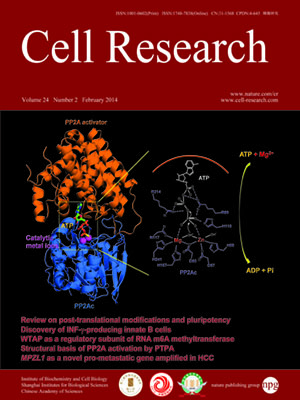
Volume 24, No 2, Feb 2014
ISSN: 1001-0602
EISSN: 1748-7838 2018
impact factor 17.848*
(Clarivate Analytics, 2019)
Volume 24 Issue 2, February 2014: 161-176 | Open Access
ORIGINAL ARTICLES
Identification of IFN-γ-producing innate B cells
Yan Bao1,2,*, Xingguang Liu2,*, Chaofeng Han2, Sheng Xu2, Bin Xie2, Qian Zhang2, Yan Gu2, Jin Hou2, Li Qian2, Cheng Qian2, Huanxing Han1 and Xuetao Cao2
1Translational Medicine Center, Changzheng Hospital, Second Military Medical University, Shanghai 200433, China
2National Key Laboratory of Medical Immunology & Institute of Immunology, Second Military Medical University, Shanghai 200433, China
Correspondence: Xuetao Cao, Tel: (+86)-21-5562 0605; Fax: (+86)-21-6538 2502 E-mail: caoxt@immunol.org; Yan Bao, Tel: (+86)-21-8187 1910; Fax: (+86)-21-8187 1909(baoy_smmu@163.com)
Although B cells play important roles in the humoral immune response and the regulation of adaptive immunity, B cell subpopulations with unique phenotypes, particularly those with non-classical immune functions, should be further investigated. By challenging mice with Listeria monocytogenes, Escherichia coli, vesicular stomatitis virus and Toll-like receptor ligands, we identified an inducible CD11ahiFcγRIIIhi B cell subpopulation that is significantly expanded and produces high levels of IFN-γ during the early stage of the immune response. This subpopulation of B cells can promote macrophage activation via generating IFN-γ, thereby facilitating the innate immune response against intracellular bacterial infection. As this new subpopulation is of B cell origin and exhibits the phenotypic characteristics of B cells, we designated these cells as IFN-γ-producing innate B cells. Dendritic cells were essential for the inducible generation of these innate B cells from the follicular B cells via CD40L-CD40 ligation. Increased Bruton's tyrosine kinase activation was found to be responsible for the increased activation of non-canonical NF-κB pathway in these innate B cells after CD40 ligation, with the consequent induction of additional IFN-γ production. The identification of this new population of innate B cells may contribute to a better understanding of B cell functions in anti-infection immune responses and immune regulation.
10.1038/cr.2013.155
FULL TEXT | PDF
Browse 2371


